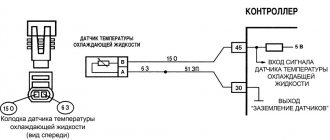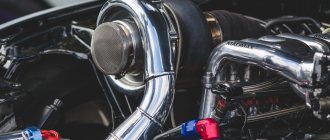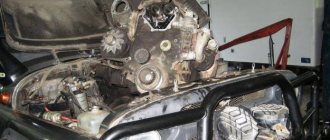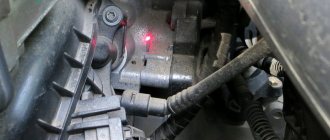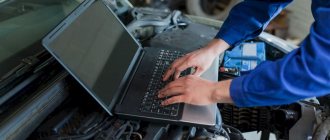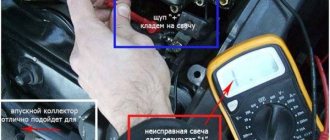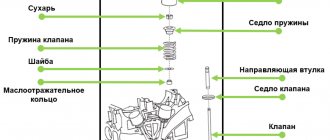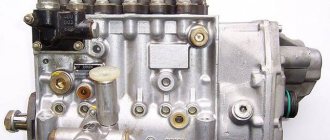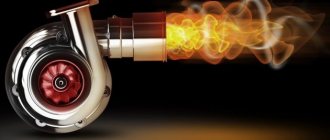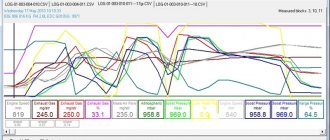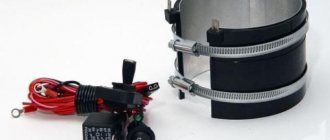What to do if the diesel engine breaks down?
Do you know, friends, why diesel engines are called the devil's engines? No..? And what does Satan have to do with it, you ask? Here's the thing. The most common reasons for this rather biased attitude of some motorists towards this type of internal combustion engine (ICE) can be attributed to the specific nuances of its operation on diesel fuel (DF), which rumbles constantly during its operation, and also vibrates strongly and collects enough energy inside itself. a lot of soot emitted by a powerful engine from the depths of the exhaust pipe into the atmosphere. Note that recently these unpleasant nuances, once tightly associated with the diesel engines themselves, are gradually fading into the background. All modern diesel engines have now become much more environmentally friendly and have become very fond of the nature around us. However, there is another reason for this attitude of drivers and other citizens towards diesel engines. This is a certain factor that at some point they can seriously fail and go to pieces, and then everything will fall on the “card” at once, that is, your health and even human life! Therefore, this engine is considered by many citizen motorists to be “The True Satan!”
See also: Warming up a cold engine: An alternative opinion
You, friends, certainly may have once heard about such an unusual phenomenon as a diesel engine blowing up, and perhaps you yourself once had not the most pleasant moments of dealing with this phenomenon with a “frenzied diesel engine.”
Although this is rare, it still happens (the further we move from the beginning of Rudolf Diesel’s creation of his first prototype, the less common this phenomenon is). But to say this for sure, many of you may never have the chance to encounter this phenomenon. Although, to our regret, this cannot be said one hundred percent today. So friends, let’s better be fully armed and together curb (at least) in theory this uncontrolled diesel engine. see also
How to turn off a diesel engine that has gone crazy: tips
We will try to tell you in as much detail as possible about the main point, what can cause such a problem and the risks associated with it, as well as how we can quickly put an end to this rapidly developing situation .
Everything you need to know about the scandal with
Got into trouble
Examples of the use of the word peddling in literature.
Of course, the ball in the Mabille garden is not the Polymnian dances on the Janiculum Hill, but the haberdashery peddler is stalking the lorette there, just like Staphilus's pimp, the virgin Planesia.
Willis and Zimmer turned off the engine, which had gone haywire, and P.G. began lowering the rocking helicopter, glad that they had only climbed fifty feet.
Seeing, however, that the noblewoman was not angry, Demid spoke more briskly: “A small merchant often peddles his trade from a German.”
Then the moment comes when the Executor realizes that all his desires are coming true - and, one might say, he walks away, intoxicated with his own power.
Yes, and all trade from the Germans goes through us, and in the volosts we also sell German goods ourselves!
They also include peddlers, day laborers, small businessmen and company managers, as well as successful, very wealthy entrepreneurs.
Ten years ago I was peddling and carrying a suitcase from house to house.
During the war, he was a peddler, even without a patent, a tramp, illegally selling textile goods, a small speculator, wandering from village to village, either by train or on foot, walking kilometer after kilometer of country roads, through dense forests to remote farms, with a dirty leather bag behind his shoulders, or even with a basket or dilapidated suitcase in his hand.
Finally I heard my heart begin to pound decisively, the blood rushed to my face, and sweat appeared.
In most cases, the rockets exploded from the bottom and side of the engines, the destroyed turbine and compressor went wild and the blades flying in all directions chopped up everything in their path worse than shrapnel.
This incident had tragic consequences - while going on a control flight after repairs, Major Kozovoy came under fire from the DShK, the tail rotor with a shot off blade went haywire, the damaged tail boom collapsed, and the out-of-control vehicle collapsed, burying the entire crew.
The reasons were in Moscow, as Mikhalych explained, wincing, after reading out the order about the failure of the next Panjshir operation, that the civilians were peddling the military machine.
Ipat left the hospital earlier and went to the front again, and Nikon, having met October in Moscow, decided to save some money before returning to the village and took up peddling.
At the beginning of the next summer, when she was again blissfully jogging through the Ilyichevsk hills and forests, Denis and Anton were filming location in the Baltic States, her mother-in-law was in the hospital, and Philip, instead of going crazy in an empty apartment, suddenly became interested in radio engineering and became make decent money by turning your room into a workshop.
The most unpleasant thing that can happen on a nuclear ship happened - the reactor went haywire, approaching an uncontrolled regime, which naturally culminates in a super-powerful explosion.
He went wild
What is diesel engine runaway?
First, a short note. -When a diesel engine goes into overdrive, this means that its speed begins to increase extremely quickly and uncontrollably and goes beyond the red line on the tachometer. At this moment, extraneous noise, black smoke, soot appear, and sometimes flames can be emitted, and all this at the same time, as a “bonus,” comes straight out of the exhaust pipe.
Characteristic
Sometimes you hear “diesel has gone bad.” What does it mean? Overrun is an uncontrolled increase in engine crankshaft speed, regardless of the position of the accelerator pedal. In most cases, the driver cannot control this process. The crankshaft rotates at high speed, which is constantly increasing.
Sometimes the revs reach 5 thousand. This is dangerous for a diesel engine. This action occurs for several minutes. The result is a jammed power unit. Often accompanied by thick black smoke from the exhaust pipe.
What are the risks if the engine breaks down?
There are two ways the situation could develop. One is dangerous and the other is very unpleasant.
First option. If the engine starts to spin while driving, then the car becomes like an angry metal mustang, it begins to accelerate uncontrollably, which in the worst case can lead to an accident, and here everything depends on the level of driving skill and the instant ability to adequately respond to an extremely developing situation. If the driver is okay with this, then the consequences themselves will not go beyond the bounds of reason.
Second example. If this incident happened in a parking lot/parking lot, that is, precisely when the car is operating in neutral mode, then the engine, having reached its prohibitive speed in an abnormal operating mode, will continue to spin until it stops completely, it will simply fail. Depending on certain conditions, the motor can literally demolish its “tower”, thus tearing off the block head and subsequently scattering all its insides over the immediate surrounding area.
What does a runaway engine mean - the main reasons
No mechanism lasts forever. A car engine is no exception. Engine overrun in this case means a sharp and uncontrolled increase in speed caused by its malfunction. This problem is mainly typical for diesel engines, although gasoline is no exception.
This mode of engine operation can be observed immediately after starting it or during a sharp decrease in load. For example, overrunning may appear when the accelerator is released, after which it suddenly begins to rapidly gain momentum and does not respond to pressing the gas pedal.
Among the reasons that could become a decisive factor for such a serious breakdown are the following malfunctions:
- High pressure fuel pump malfunction. The fact is that a gasoline engine regulates the supply of the mixture by changing the position of the throttle valve, and a diesel engine by controlling the intake nozzle. The fuel rack of the pump is driven by the engine crankshaft, which means its performance is directly dependent on the number of engine revolutions. To maintain the required speed, the system has a centrifugal regulator that controls the amount of mixture supplied to the engine cylinders. If the fuel rail becomes stuck, the centrifugal governor remains in the set position and the engine can either stall or continue to operate with a gradual increase in speed.
- Oil capture. Most diesel engines have crankcase ventilation that is closely connected to the engine intake manifold. If the engine is worn out enough, the gases generated in the combustion chamber break through the oil scraper rings and enter the crankcase. Then they, mixing with oil gas, pass into the intake manifold. The main problem is that diesel car oil has the same energy when burned as diesel fuel. Thus, a new mixture is obtained, which causes a sudden increase in engine crankshaft speed.
This problem almost always leads to the following problem. After this process, as a rule, the engine is repaired and oil particles remaining in the intercooler or compressor are not always removed by inexperienced technicians. In this regard, the engine separation is repeated again. Gases can also enter due to a malfunction of the turbocharger seals, and other minor problems of turbocharged diesel engines.
What Causes Diesel Engine Overrun?
The speed of a gasoline engine is controlled by a throttle valve, which allows more or less air to enter the cylinders where more or less fuel is burned. In accordance with this, the engine begins to produce, either in its minimum or in its maximum range, the corresponding and necessary power. In a diesel engine, the amount of this air has no restrictions; it is, as a rule, regulated by the amount of fuel itself that is injected into the cylinders.
Thus, as long as there is air supplied and something to burn inside the cylinders themselves, the diesel engine will continue to work until one of these components runs out. And in order to completely burn the fuel, it only needs, as is known, pressure; in these cases, no sparks should appear, as in gasoline engines.
Modern diesel engines are more protected from those specific defects that cause them to go into disarray, since the amount of fuel in them is strictly calculated electronically and injected in doses. It is calculated using a computer and depends on many factors. Even if something suddenly happens to the gas pedal (electronic gas pedal), the computer will instantly “cut” the volume of fuel supplied in accordance with the required amount at idle, and this will happen exactly when you press the brake pedal. Just half a second, even a fraction of a second, will be enough for the on-board computer to immediately calculate the situation and make the only correct and correct decision for you.
However, friends, this is still not the main thing; improper operation of the accelerator pedal is the least common reason for this phenomenon. You should pay more attention to other possible causes, namely, combustible fuels that may enter the combustion chamber in addition to the existing diesel fuel.
For example, if the car is located in an area of accumulation of natural gases or propane, then this can cause the engine to run out, and it only becomes so when the gas evaporates on its own or the air supply is manually shut off. Some engines can run on coal dust and even oils. As a reminder to our motorists, we, for our part, believe that you should definitely know about this, that when the diesel engine was invented, as such, the concepts of diesel and fuel for it, i.e. solariums did not yet exist; that ancient engine ran only on vegetable oil.
Speaking about oils, it is necessary to say right away that this was the most common reason why a diesel engine began to “go crazy”. You probably, friends, will immediately want to ask us, “Who in their right mind would pour oil into the intake manifold of an engine,” but..., don’t rush and don’t get ahead of things, dear friends, don’t forget that for your proper operation The engine must consume a sufficiently large amount of oil.
Yes, no one hides the fact that motor oil is the biggest and most dangerous enemy and it can get into the engine cylinders in only two ways, namely, the first way is through the turbocharger, the second is through the crankcase ventilation tube.
Deadly auto scandals: “VW vs GM” vs “Toyota”
As many of you probably know, a turbocharger rotates at a speed equal to thousands of revolutions per minute. This is necessary primarily in order to force more air into the engine. To prevent this expensive part from breaking immediately at the start of operation, that is, after the first start of the engine, oil is used to lubricate the working group of the turbocharger and maintain normal temperatures.
And if, over time, the tightness in the engine is broken, then along with the air pumped by the turbine, oil will also get there, which means combustion in the chamber will begin to occur faster and more intensely, the engine will begin to gain speed and spin faster and faster until the lubricant completely runs out or specific self-destruction. In any position, nothing good can be expected from this.
Poor sealing usually allows engine oil to enter the engine itself, this happens through the crankcase ventilation. The crankcase is connected by hoses to the intake manifold; this is done to ventilate the resulting oil vapors during engine operation. If the piston rings are worn out and old, they will not completely seal the combustion chamber when diesel fuel ignites. From here the pressure begins to seep into the crankcase and push (pump) more and more generated vapors into the cylinder, and this happens all the time, just some kind of vicious circle..(?)
The same thing happens when an excessive amount of motor oil enters the engine, which usually leads to the same situation.
If the injection pump (high pressure fuel pump) is faulty. The fuel pump itself is driven from the engine crankshaft directly through the gearbox; its performance directly depends on the rotation speed of the engine shaft. To maintain a given engine speed, a centrifugal governor is used, which limits the fuel supply as the rotation speed increases.
If the fuel injection pump rack jams, this can lead to two unpleasant consequences, namely, in the first case, the engine will stall, in the second, it will go into overdrive.
Engine spacing. Working on motor oil. What you need to know to prevent this from happening.
The engine is the most complex mechanism in a car. During its operation, various types of breakdowns may occur. Most of them do not cause much harm, and are corrected on their own or by driving to a hundred. But there are malfunctions that can seriously damage the engine, and even major repairs may not help in all cases. We are talking about a breakdown as a result of which the engine begins to spontaneously increase speed to the maximum possible. This situation is called engine runaway.
Engine runaway is a spontaneous, uncontrolled increase in speed to the maximum possible for a given design. This malfunction is inherent in diesel engines; gasoline engines rarely suffer from it, because the principle of regulating the speed and power of these engines differs from diesel engines in that a throttle valve is installed in the intake system, which limits the air supply and prevents the engine from spinning spontaneously. A diesel engine is controlled by the fuel supply and the amount of air that enters its cylinders is limited only by the parameters of the gas distribution mechanism and the intake system. This means that if any unusual situations arise, the driver may lose control over engine speed. This can happen if the fuel supply system is faulty. In the fuel pump, the centrifugal speed controller that controls the rack may fail. More fuel will begin to flow into the cylinders. As a result, the speed will begin to increase spontaneously, and the engine will reach an operating mode at which it can literally be blown apart. This can lead to the following breakdowns: the crankshaft breaks off, the pistons burn out, the connecting rods come off and the block is pierced.
When the engine starts to run, thick black smoke comes out of the exhaust system.
From the above, it can be understood that engine runaway is caused by uncontrolled fuel supply to the cylinders. A diesel engine is designed in such a way that it can be fueled not only by diesel fuel, but also by motor oil. This means that if it gets into the cylinder, the engine will run, even if the fuel supply is completely stopped. Control over his work will completely disappear. The result is twisting of the crankshaft and runaway. Engine oil can get into the cylinders, for example, as a result of wear of the piston group. A large amount of gases will break into the crankcase, and since oil mist is formed here during engine operation, the gases will capture it and carry it through the crankcase ventilation system to the intake. As a result, the oil will end up in the cylinder. Due to the high degree of compression, the air in a diesel engine heats up to a temperature at which the oil can begin to burn. Therefore, a diesel engine can run on one oil.
How to stop spreading?
To stop diesel engine runaway you will have to either reduce fuel or cut off the air supply. However, take your time, if you encounter this while driving, then increasing the mechanical load will become a priority and necessary task for you in order to normalize engine operation.
In any case, it is better to first make sure that such actions are safe.
We understand our motorists that this sounds kind of stupid in such an extreme current situation, but still, friends, try not to lose your heads.
Next, we will describe the general rule of guidance for our readers, but we will do this only theoretically. Using this guide in practice, and especially under a variety of circumstances, may not lead car owners to the desired result.
If diesel engine runaway starts while driving a car, then you should personally and certainly feel the unexpected acceleration. Take your foot off the accelerator pedal and press the brake, while trying to monitor the car following you from behind, how close it is to you, this must be done in order to avoid a collision. Never put the engine of a car above your own life (or the lives of others). Let it scream and roar with all its might and let it reach speeds unimaginable at that moment, immediately put the speed in neutral and your car will stop accelerating, and then start snuggling to the side of the road.
The most important thing is don’t panic, if you have an automatic transmission, then most automatic transmissions allow you to select neutral gear and stop right on the move.
Did you feel scared to do anything after all the time you stopped, and even more so after you personally saw what was happening? Please don’t be alarmed, friends, let the engine in the car work, sooner or later it will use up all the available fuel or simply break down due to the catalytic process of the oil entering the cylinders. In the meantime, you will concentrate and become better at calling emergency services. And please, try to warn other road users about the emergency situation that has occurred with the car.
Try not to be scared or afraid in this situation, but act immediately. The very first quick and reliable way to turn off the engine is to use a fire extinguisher, which should usually always be in the car. Grab it and immediately open the hood of the car, then spray the entire contents of the fire extinguisher right next to the intake valve. You don't know where it is? Then start spraying the entire contents of the fire extinguisher throughout the engine compartment. The CO2 concentration will replace the necessary air that is needed for fuel combustion. All this should lead to the engine stopping. This method also works in those very cases where flammable gases begin to leak and enter the atmosphere around the car itself.
If this reason turns out to be that oil got into the intake manifold, then this should certainly cause huge clouds of smoke that will come out of the exhaust pipe. If smoke begins to cover the entire car, then at this moment it is better for you to move away from it and immediately call emergency services by phone 112.
If you don’t have a fire extinguisher in your car, what should you do? There is another way to reduce the air supply to the engine. You need to manually block the air flow, that is, take a piece of some kind of rag or piece of plywood. If you close the intake valve with them, and the engine is still running, this will mean that air is still leaking somewhere around the perimeter and this is quite enough to burn fuel in the cylinders.
You can do the same with a manual transmission. You need to put it in the highest gear and then sharply press the brake and sharply release the clutch. This should create a lot of resistance and the engine should stall.
We hope, friends, that everything will work out for you.
Why the engine starts to run apart - determine the reason
The last breakdown is very dangerous, as it can lead to the following consequences:
- a fire that occurred in the exhaust manifold;
- jamming of the engine due to overheating;
- and even its destruction due to increased mechanical loads.
So, the engine has gone into overdrive, and the reasons may be different, which means that in order to eliminate the problem that has arisen, it is extremely important to identify what exactly contributed to the occurrence of the overrun. If you see thick smoke coming out of the muffler and the speed increases sharply, then most likely the turbine is faulty. And one of the reasons for turbocharging malfunction, in turn, is an oil leak. In this case, even if the fuel supply is turned off, it is quite possible for the engine to continue to operate, just on oil.
If the cause is a faulty fuel rail of the injection pump, then this leads to overheating of the engine with all the ensuing consequences. This can also be determined by black diesel fuel, which has air bubbles in the “return”.
What should you do after you have stopped the diesel engine?
Even when you did everything correctly and quickly stopped the engine, try NOT to START it again under any circumstances. If this problem catches you on the road, then park your car in a safe place, turn on the emergency lights and call a tow truck. You need to take the car to a car service center, where they will study the situation in detail and determine the cause of the illness.
If your car is parked in the middle of the road and is interfering with the passage of other vehicles, then anyway, take your time and set it to the hazard lights, or better yet, try to roll it to the side of the road WITHOUT STARTING THE ENGINE!
Our video clip above clearly shows everything that can happen when an engine runs out of control, and also how some experienced motorists were able to stop an out of control engine. And friends, there is one more precaution that we want to inform you about, namely, if you try to stop the air supply to the engine directly through the turbocharger (as the American did and as shown in the second video), then please be extremely careful not to accidentally get your fingers into the turbine rotor!
Eliminating engine runaway
When your car has an engine breakdown, the first thing you should do is stop the fuel supply; this can be done by disconnecting the fuel supply pipe. Then load the engine. The required load can be given as follows: having engaged the fourth or fifth gear, sharply press the brake. After these steps, the engine should stall. If these measures do not produce results, then you must also shut off the air supply to the system. However, this is not so easy to do, since if you have a turbine, a simple rag will not help, you need something more substantial.
